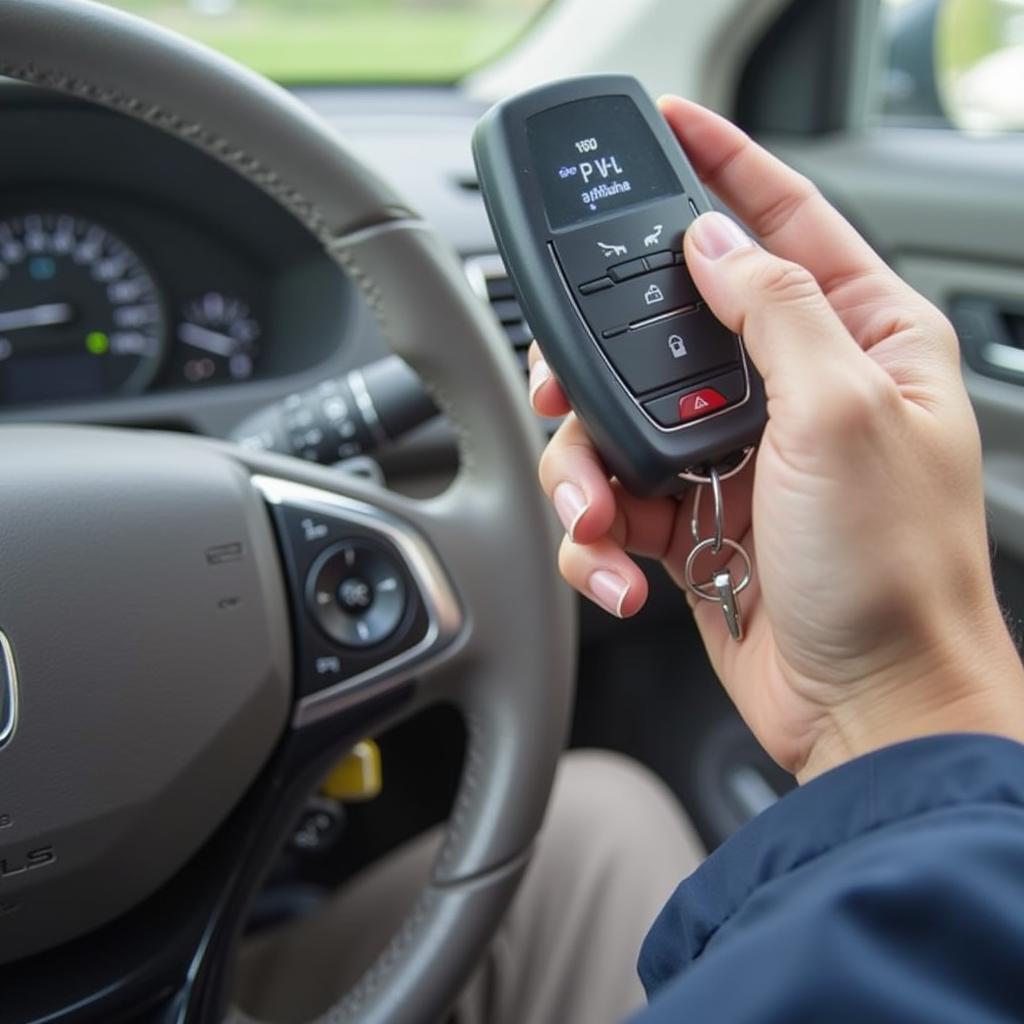The dreaded toyota brake warning light rav4. Seeing it illuminate on your dashboard can be unnerving. This article will delve into the common causes of the brake warning light in a Toyota RAV4, offering troubleshooting tips and solutions to help you get back on the road safely. We’ll cover everything from simple checks you can perform yourself to more complex issues that may require professional assistance.
 Toyota RAV4 Brake Warning Light Illuminated on Dashboard
Toyota RAV4 Brake Warning Light Illuminated on Dashboard
Understanding the Toyota RAV4 Brake Warning Light
The brake warning light in your Toyota RAV4 can signal a few different problems. It’s essential to understand what each potential issue could be so you can take appropriate action. The light could indicate low brake fluid, worn brake pads, a problem with the ABS (Anti-lock Braking System), or even a malfunctioning parking brake. Ignoring the warning light can lead to serious safety risks, so addressing the issue promptly is crucial. Read on to learn how to identify the specific problem and implement effective solutions. toyota rav4 brake warning light offers more specific information about this model.
Common Causes and Solutions
Low Brake Fluid
One of the most common reasons for the brake warning light to come on is low brake fluid. This is often caused by worn brake pads, as the brake calipers need more fluid to compensate for the reduced pad thickness.
- Solution: Check your brake fluid reservoir. If it’s low, top it off with the correct type of brake fluid specified in your owner’s manual. However, consistently low brake fluid indicates a leak, which requires immediate professional attention.
Worn Brake Pads
Worn brake pads are another frequent culprit. Your RAV4’s brake pads have wear indicators that trigger the warning light when they reach a certain level of wear.
- Solution: If your brake pads are worn, they need to be replaced. This is a relatively straightforward job that can be done by a qualified mechanic or even a skilled DIYer. You can find more information about resetting the brake pad warning light at how to reset mini brake pad warning.
ABS Issues
A problem with the ABS can also trigger the brake warning light. The ABS helps prevent wheel lockup during hard braking, maintaining steering control.
- Solution: If the ABS light is also illuminated, this points towards a potential issue within the ABS system itself. Diagnosing and repairing ABS issues requires specialized diagnostic equipment, so it’s best to consult a qualified mechanic. brake warning light toyota rav4 can give you further insight into this.
Faulty Parking Brake Switch
Sometimes, a malfunctioning parking brake switch can be the source of the problem.
- Solution: Try engaging and disengaging the parking brake several times. If the light goes off, the switch might be the issue. Replacing the switch is usually a simple fix.
Troubleshooting Your Toyota RAV4 Brake Warning Light
Why is my toyota brake warning light rav4 on?
The toyota brake warning light rav4 can be triggered by various issues, including low brake fluid, worn brake pads, a faulty parking brake switch, or problems with the ABS system.
How do I fix my toyota brake warning light rav4?
Fixing the toyota brake warning light rav4 depends on the underlying cause. Check your brake fluid level and add more if it’s low. If your brake pads are worn, replace them. If the parking brake switch is faulty, have it replaced. For ABS issues, consult a qualified mechanic. You can learn more about the RAV4’s brake system warning light at toyota rav4 brake system warning light.
What if the light stays on after checking these things?
If the brake warning light persists after these checks, it’s crucial to take your RAV4 to a qualified mechanic for a thorough diagnosis. rav4 brake system warning light has detailed resources for this situation.
 Mechanic Inspecting Toyota RAV4 Brakes
Mechanic Inspecting Toyota RAV4 Brakes
“Regular brake system maintenance is essential for safe driving. Don’t neglect your brake warning light—it’s there for a reason.” – John Smith, Certified Automotive Technician.
“Ignoring your brake warning light can lead to expensive repairs down the line. Addressing the issue promptly can save you time and money.” – Jane Doe, Senior Automotive Engineer.
Conclusion
The toyota brake warning light rav4 is a crucial safety indicator. Understanding its potential causes and implementing appropriate solutions is vital for maintaining your vehicle’s safety and reliability. While some issues can be resolved with simple checks and fixes, others require professional attention. Never ignore the brake warning light. Addressing the problem promptly can prevent more serious issues and ensure your safety on the road.
FAQ
-
Is it safe to drive with the brake warning light on? No, it’s not generally safe to drive with the brake warning light illuminated. It indicates a potential problem with your braking system that needs to be addressed.
-
How often should I check my brake fluid? It’s a good idea to check your brake fluid level at least once a month.
-
How long do brake pads typically last? Brake pad lifespan varies depending on driving habits and conditions, but they typically last between 25,000 and 70,000 miles.
-
What does the ABS light mean? The ABS light indicates a problem with the Anti-lock Braking System.
-
Can I replace my brake pads myself? Replacing brake pads is a job that can be done by a DIYer with the right tools and experience, but it’s recommended to consult a professional if you’re unsure.
-
How much does it cost to replace brake pads? The cost of brake pad replacement varies depending on the vehicle and location, but it typically ranges from $150 to $300 per axle.
-
What should I do if my brake warning light comes on after I’ve replaced the brake pads? If the light remains on after replacing the brake pads, there might be another issue, such as a faulty sensor or low brake fluid. Consult a mechanic for further diagnosis.

